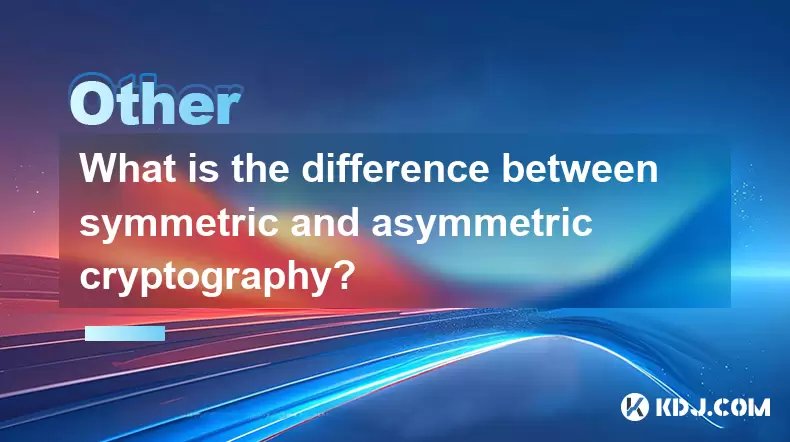-
 Bitcoin
Bitcoin $119600
0.87% -
 Ethereum
Ethereum $4290
1.45% -
 XRP
XRP $3.201
-0.02% -
 Tether USDt
Tether USDt $0.0000
-0.01% -
 BNB
BNB $808.8
0.81% -
 Solana
Solana $177.9
-2.52% -
 USDC
USDC $0.9999
0.01% -
 Dogecoin
Dogecoin $0.2307
-1.44% -
 TRON
TRON $0.3445
1.50% -
 Cardano
Cardano $0.7918
-1.64% -
 Hyperliquid
Hyperliquid $43.77
-2.82% -
 Chainlink
Chainlink $21.54
-2.97% -
 Stellar
Stellar $0.4416
-0.67% -
 Sui
Sui $3.711
-4.08% -
 Bitcoin Cash
Bitcoin Cash $589.2
3.28% -
 Hedera
Hedera $0.2509
-3.44% -
 Ethena USDe
Ethena USDe $1.001
-0.02% -
 Avalanche
Avalanche $23.44
-1.96% -
 Litecoin
Litecoin $124.6
0.94% -
 Toncoin
Toncoin $3.410
2.06% -
 UNUS SED LEO
UNUS SED LEO $9.030
0.06% -
 Shiba Inu
Shiba Inu $0.00001320
-2.68% -
 Uniswap
Uniswap $11.41
4.29% -
 Polkadot
Polkadot $3.930
-3.63% -
 Cronos
Cronos $0.1682
3.46% -
 Dai
Dai $1.000
0.00% -
 Ethena
Ethena $0.7936
2.17% -
 Bitget Token
Bitget Token $4.427
-0.52% -
 Monero
Monero $269.6
0.01% -
 Pepe
Pepe $0.00001158
-4.09%
What is the difference between symmetric and asymmetric cryptography?
Cryptography underpins cryptocurrency security through symmetric and asymmetric encryption, ensuring private, authentic, and tamper-proof transactions.
Aug 11, 2025 at 12:21 pm

Understanding the Foundations of Cryptography
Cryptography is the cornerstone of secure communication in the cryptocurrency ecosystem. It ensures that transactions remain private, authentic, and tamper-proof. At its core, cryptography relies on mathematical algorithms to protect data. Two primary models dominate this field: symmetric cryptography and asymmetric cryptography. Both play vital roles in blockchain technology, wallet security, and transaction validation. Understanding their differences is essential for anyone engaging with digital assets.
Symmetric Cryptography Explained
Symmetric cryptography uses a single secret key for both encryption and decryption. This means the sender and receiver must possess the same key to communicate securely. The simplicity of this model makes it fast and efficient, especially for encrypting large volumes of data. In the context of cryptocurrency, symmetric encryption is often used in internal processes, such as securing wallet files or encrypting local data storage.
Common algorithms in this category include AES (Advanced Encryption Standard) and DES (Data Encryption Standard). To use symmetric encryption effectively:
- Generate a strong, random secret key.
- Share the key securely with the intended recipient.
- Use the key to encrypt the plaintext message.
- Transmit the encrypted message.
- The recipient uses the same key to decrypt the message.
The main challenge lies in secure key distribution. If the key is intercepted during transmission, the entire communication becomes compromised. This limitation makes symmetric cryptography less ideal for open networks like the internet, where parties may not have pre-established trust.
Asymmetric Cryptography Explained
Asymmetric cryptography, also known as public-key cryptography, uses a pair of mathematically linked keys: a public key and a private key. The public key can be freely shared and is used to encrypt messages or verify signatures, while the private key must remain secret and is used to decrypt messages or create digital signatures.
This model solves the key distribution problem inherent in symmetric systems. In cryptocurrency, asymmetric cryptography is foundational. It enables users to receive funds via their public address (derived from the public key) while ensuring only the owner, who holds the private key, can authorize transactions.
Key algorithms include RSA and Elliptic Curve Cryptography (ECC). Bitcoin and Ethereum use ECC with the secp256k1 curve for generating key pairs. To implement asymmetric encryption:
- Generate a public-private key pair using a cryptographic library.
- Distribute the public key openly.
- Others encrypt messages using your public key.
- Only you can decrypt those messages with your private key.
Digital signatures, a critical component of blockchain transactions, also rely on this system. A user signs a transaction with their private key, and others verify it using the corresponding public key.
Comparing Security and Performance
When evaluating symmetric vs asymmetric cryptography, performance and security trade-offs become apparent. Symmetric encryption is significantly faster and requires less computational power, making it suitable for encrypting large datasets. However, its reliance on a shared secret introduces risks if the key is exposed.
In contrast, asymmetric cryptography provides enhanced security through key separation but is computationally intensive. Encrypting large messages directly with public keys is inefficient. For this reason, hybrid systems are often employed: symmetric encryption secures the data, while asymmetric encryption securely exchanges the symmetric key.
For example, in secure communication protocols used by cryptocurrency wallets or exchanges:
- A symmetric session key is generated for fast data encryption.
- This session key is then encrypted using the recipient’s public key.
- The encrypted data and encrypted session key are sent together.
- The recipient uses their private key to decrypt the session key.
- The session key is then used to decrypt the actual message.
This approach combines the speed of symmetric encryption with the secure key exchange of asymmetric systems.
Applications in Cryptocurrency Networks
Both cryptographic models are deeply embedded in blockchain operations. When a user creates a cryptocurrency wallet, a private key is generated using asymmetric cryptography. From this, a public key is derived, which is then hashed to produce the wallet address. This address can be shared publicly to receive funds.
Every transaction on the network is signed with the sender’s private key, ensuring authenticity and non-repudiation. Nodes on the network verify the signature using the sender’s public key, confirming the transaction’s legitimacy without exposing sensitive information.
Meanwhile, symmetric cryptography is used in areas such as:
- Encrypting wallet files stored on a user’s device using AES-256.
- Securing communication between nodes via TLS, which employs symmetric ciphers after an asymmetric handshake.
- Protecting backup phrases or seed vaults with password-based encryption.
These applications highlight how both systems complement each other within the cryptocurrency infrastructure.
Key Management and Best Practices
Proper key management is critical in both models. For symmetric cryptography, the secret key must be stored securely, ideally using hardware security modules (HSMs) or encrypted storage. Never transmit the key over unsecured channels.
For asymmetric cryptography, the private key must never be exposed. Best practices include:
- Storing private keys in hardware wallets or secure enclaves.
- Avoiding digital copies on internet-connected devices.
- Using multi-signature schemes to distribute control across multiple keys.
- Regularly auditing access to cryptographic materials.
Loss of a private key in asymmetric systems means permanent loss of access to associated funds—a common issue in cryptocurrency due to human error.
Frequently Asked Questions
Can symmetric cryptography be used for digital signatures in cryptocurrency?
No, symmetric cryptography cannot be used for digital signatures. Digital signatures require the mathematical relationship between a private and public key, which is only possible in asymmetric systems. Symmetric methods lack the mechanism to prove ownership without revealing the secret key.
Why do cryptocurrencies like Bitcoin use elliptic curve cryptography instead of RSA?
Elliptic Curve Cryptography (ECC) offers equivalent security to RSA with much smaller key sizes. A 256-bit ECC key provides similar protection to a 3072-bit RSA key, making ECC more efficient in terms of storage and computation—critical for decentralized networks with limited bandwidth and processing power.
Is it possible to derive a private key from a public key in asymmetric cryptography?
No, it is computationally infeasible to derive the private key from the public key due to the mathematical properties of one-way functions used in ECC or RSA. This security relies on problems like the elliptic curve discrete logarithm problem, which current computers cannot solve in a reasonable time.
What happens if two people generate the same private key in a cryptocurrency system?
The probability of generating the same 256-bit private key is astronomically low—comparable to winning the lottery multiple times in a row. If it did happen, both individuals could access the same funds. However, the design of cryptographic random number generators makes this scenario effectively impossible in practice.
Disclaimer:info@kdj.com
The information provided is not trading advice. kdj.com does not assume any responsibility for any investments made based on the information provided in this article. Cryptocurrencies are highly volatile and it is highly recommended that you invest with caution after thorough research!
If you believe that the content used on this website infringes your copyright, please contact us immediately (info@kdj.com) and we will delete it promptly.
- Bitcoin, Solana, MAGACOIN FINANCE: Navigating the 2025 Crypto Landscape
- 2025-08-12 00:30:13
- Paxos, Circle, Ripple License: Navigating the Shifting Sands of Stablecoin Regulation
- 2025-08-12 02:10:12
- Cardano, ADA Holders, and Layer Brett: A Meme Coin with Real Utility?
- 2025-08-12 00:50:12
- Bitcoin, Michael Saylor, and Savvy Investors: A New Era of Digital Assets
- 2025-08-12 00:30:13
- Crypto Presales in 2025: Spotting the Next Big Thing with Analyst Insights
- 2025-08-12 00:50:12
- Cloud Mining in 2025: Bitcoin, Litecoin, and the Quest for Passive Income
- 2025-08-12 00:55:32
Related knowledge

How can zero-knowledge proofs enhance privacy on a blockchain?
Aug 12,2025 at 02:15am
Understanding Zero-Knowledge Proofs in Blockchain ContextZero-knowledge proofs (ZKPs) are cryptographic protocols that allow one party (the prover) to...

What is the difference between gas price and gas limit?
Aug 09,2025 at 08:42pm
Understanding Gas in Ethereum and EVM-Based NetworksIn blockchain networks that support smart contracts—particularly Ethereum and other EVM (Ethereum ...

What is gas limit in Ethereum?
Aug 11,2025 at 04:29am
Understanding the Concept of Gas in EthereumIn the Ethereum network, gas is a unit that measures the computational effort required to execute operatio...

What is a "mempool"?
Aug 11,2025 at 02:49am
Understanding the Mempool in Cryptocurrency NetworksThe mempool, short for memory pool, is a critical component of blockchain networks like Bitcoin an...

What is a transaction fee in blockchain?
Aug 08,2025 at 09:21pm
Understanding the Basics of Blockchain Transaction FeesA transaction fee in blockchain is a small amount of cryptocurrency paid by a user to process a...

What hardware is needed for crypto mining?
Aug 10,2025 at 08:22pm
Understanding the Role of GPUs in Crypto MiningWhen discussing the hardware required for crypto mining, the Graphics Processing Unit (GPU) stands out ...

How can zero-knowledge proofs enhance privacy on a blockchain?
Aug 12,2025 at 02:15am
Understanding Zero-Knowledge Proofs in Blockchain ContextZero-knowledge proofs (ZKPs) are cryptographic protocols that allow one party (the prover) to...

What is the difference between gas price and gas limit?
Aug 09,2025 at 08:42pm
Understanding Gas in Ethereum and EVM-Based NetworksIn blockchain networks that support smart contracts—particularly Ethereum and other EVM (Ethereum ...

What is gas limit in Ethereum?
Aug 11,2025 at 04:29am
Understanding the Concept of Gas in EthereumIn the Ethereum network, gas is a unit that measures the computational effort required to execute operatio...

What is a "mempool"?
Aug 11,2025 at 02:49am
Understanding the Mempool in Cryptocurrency NetworksThe mempool, short for memory pool, is a critical component of blockchain networks like Bitcoin an...

What is a transaction fee in blockchain?
Aug 08,2025 at 09:21pm
Understanding the Basics of Blockchain Transaction FeesA transaction fee in blockchain is a small amount of cryptocurrency paid by a user to process a...

What hardware is needed for crypto mining?
Aug 10,2025 at 08:22pm
Understanding the Role of GPUs in Crypto MiningWhen discussing the hardware required for crypto mining, the Graphics Processing Unit (GPU) stands out ...
See all articles

























































































